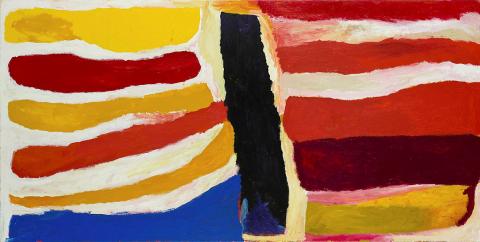Wakartu Cory Surprise’s Mimpi 2011
By Diane Moon
Artlines | 1-2012 | March 2012
A familiar desert landscape remained the central subject of senior Indigenous artist Wakartu Cory Surprise’s bold, abstract paintings throughout her artistic career, writes Diane Moon. Her work Mimpi 2011 features in the upcoming ‘Contemporary Australia: Women’ exhibition.1
Wakartu Cory Surprise (1929–2011) was one of the great women artists who began painting at Mangkaja Arts Centre in Fitzroy Crossing in the early 1980s, and a leader in her artistic group. Wakartu's bold, abstract works are joyful explorations in vivid colour of the spirit and features of her country, describing places she had walked as a young woman and knew intimately. Her deep knowledge of the desert environment and its law remained essential elements of her work and she painted about them until her last days.
In Wakartu's paintings, the sandhills of desert life are distilled into horizontal, tapered forms, representing the sheer masses of sand (jilji) that have to be physically scaled to reach precious sources of fresh water (jila). The artist knew the length and height of these parallel sand masses and their specific locations. She painted about them and around them and from above them — their importance to her never diminished. Though she faced no lack of water after moving to Fitzroy Crossing, the sites of fresh water in her country remained a constant theme, as in the circular forms of rock holes in Ngurrantili pamarr (hill) big one 2009: 'This [painting] got all the pamarr, he got water all around and big mob of jila'.2
In Mimpi 2011 — Wakartu’s final major painting — the presence of water is more subtly implied: 'Big ngapa [water] long way desert side. That ngapa is in between that jilji'.3 As well as being vital for survival in potentially hostile conditions, waterholes connected the artist with Tapu (her birth place) and her spiritual being, both of which were vital to her inner life and her art. Sandhills and living water continued to be key themes for Wakartu’s works throughout her life as a painter.
Wakartu Cory Surprise's work is distinctive for her courageous use of colour, as is evident in Mimpi. Here, singing yellows, fiery reds and deepest purple-black are handled with exciting tonal shifts and textural contrasts; we can even see how she has reworked the surface, mixing colours directly on the canvas. The artist once said about her work:
'When I paint, I think about my country, and where I have been travelling across that country. I paint from here [Surprise points to her head — thinking about country] and here [points to breasts, collarbone and shoulder blades — a reference to body painting]. I think about my people, the old people and what they told me, I think about jumangkarni (Dreamtime).'
Diane Moon is former Curator, Indigenous Fibre Art, Queensland Art Gallery | Gallery of Modern Art.
Endnotes
- ‘Contemporary Australia: Women’, Gallery of Modern Art, 21 April – 22 July 2012.
- Mangkaja Arts Resource Agency Aboriginal Corporation certificate for Ngurrantil Pamarr (Big One) 2009.
- Mangkaja Arts Resource Agency Aboriginal Corporation certificate for Mimpi 2011.
Connected objects

Mimpi 2011
- SURPRISE, Wakartu Cory - Creator
